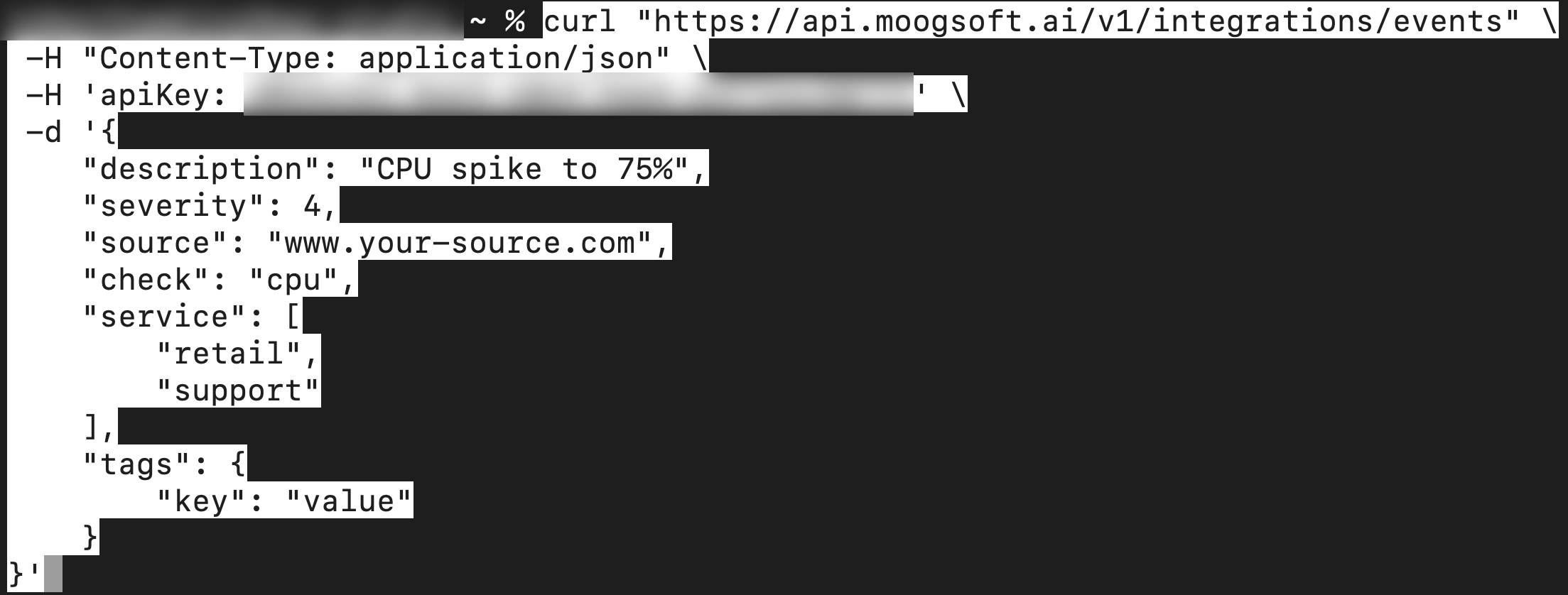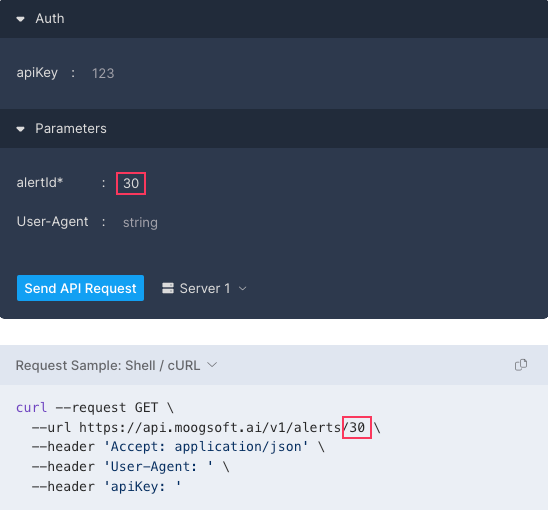Get started with APEX AIOps Incident Management APIs
Before starting to use the APEX AIOps Incident Management APIs, it is helpful to understand some basic terminology, concepts, and fundamental procedures.
Access the APIs on Incident Management API Documentation site.
API: a definition
API stands for "application programming interface." An API includes a set of protocols that allow two applications to communicate with each other. Almost anytime you interact with a web application through your browser, you are interacting with an API somewhere.
In the specific case of Incident Management, APIs can be used to perform tasks without going through the user interface. APIs can allow you to perform advanced tasks, scripted tasks, or non-standard tasks that the interface does not support.
Endpoints
An endpoint is a resource in an application that is able to interact with another software program in specific ways. It is capable of receiving a request and responding to it. An example of this in Incident Management is sending a cURL request (covered below) to an endpoint to download collector software to set up on your computer.
Some other examples of Incident Management endpoints include:
https://api.moogsoft.ai/v1/alerts-search
Performs searches for alerts.
https://api.moogsoft.ai/v2/catalogs
Returns a list of data enrichment catalogs.
https://api.moogsoft.ai/v1/incidents
Lists incidents matching specified parameters.
Endpoints can receive information in a request to update data on the system, or respond by sending information to the requester.
Parameters
A parameter, in API terms, is a piece of information passed to an API endpoint to somehow modify the endpoint response. This information could be optional, or it could be required. When requesting a collector installation by API, for example, the request must include a string parameter which indicates the OS version (platform) of the collector setup to send. Other examples of parameters for different endpoints include filters, user IDs, alert IDs, and integration names.
REST
REST is an acronym for REpresentational State Transfer. A REST, or RESTful, API is an application programming interface that conforms to the REST architectural constraints rather than a protocol standard. The REST architecture is popular for developing stateless, reliable web APIs.
Client requests to RESTful APIs are typically delivered via HTTP in one of several formats: JSON (JavaScript Object Notation), HTML, XLT, Python, PHP, or plain text, with JSON being the most popular.
The OpenAPI Specification
In general terms, the OpenAPI Specification defines a standard format for the structure and syntax of REST APIs.
Per the OpenAPI Initiative:
"The OpenAPI Specification (OAS) defines a standard, programming language-agnostic interface description for HTTP APIs, which allows both humans and computers to discover and understand the capabilities of a service without requiring access to source code, additional documentation, or inspection of network traffic. When properly defined via OpenAPI, a consumer can understand and interact with the remote service with a minimal amount of implementation logic. Similar to what interface descriptions have done for lower-level programming, the OpenAPI Specification removes guesswork in calling a service."
Swagger
Swagger was originally a way of representing an API using JSON, built upon a REST API architecture, which provided a way to try out APIs and develop against them. Swagger later was renamed as OpenAPI Specification (OAS).
Swagger is now a set of open source development tools for producing REST-based APIs that adhere to the OpenAPI Specification. These tools includes applications for designing APIs (Swagger Editor), building APIs (Swagger Codegen), and documentation (Swagger UI).
For more details, visit swagger.io.
YAML files
YAML is a programming language used for creating configuration files. It either stands for "Yet Another Markup Language" or "YAML Ain't a Markup Language," depending on your preference. YAML is popular for use in Ansible, and for Kubernetes resources and deployments.
For the purposes of Incident Management APIs, YAML files are produced as a part of the software development process and are used for documentation purposes. The Incident Management API documentation is built from auto-generated YAML files.
Using Incident Management APIs
After you grasp the basics, you can move on to experimenting with the Incident Management APIs. The Incident Management APIs are located at Incident Management API Docs.
Using cURL requests
The term cURL stands for "client URL" and it is a way to deliver data to and from a server. It supports HTTP and HTTPS, though you will always use HTTPS with Incident Management cURL commands to APIs.
Sending cURL requests to an API requires no additional setup for systems like MacOS and Linux, which have built-in shells. If you have a Microsoft-based system, you can install or enable a bash shell, depending on your OS version. Refer to the documentation from Microsoft, or search for third-party shell programs you can install on Microsoft platforms.
Note
Other languages in addition to cURL are available. Click the Request Sample menu to view the full list.

Testing API requests
To check if cURL requests are working on your system, you can send a test event that will create an alert in Incident Management.
Navigate to Integrations > Inbound Integrations.
Click Events API and copy the cURL command shown in the cURL Request box.
You can click the clipboard icon to quickly copy the entire command. Ensure you replace the
<API KEY>placeholder text with an API key for your instance.Paste the command into the command line interface of your shell program.
For Linux and MacOS users, this involves pasting at the command line. Windows users may need to run a program to start up a shell program first.

Be sure to replace the
<API KEY>placeholder text with an API key created in your instance.Press Enter.
A success message displays.
To confirm that the event in the command successfully made it to your system, navigate to Incidents > Alerts and make sure you see the test alert.
Note
You can also send commands to API service endpoints using Postman. For Postman installation instructions and educational materials, visit https://web.postman.co.
Use the API documentation to build requests
After you have tested API functionality on your system, you are ready to move on to using the APIs to perform meaningful tasks. The Incident Management API documentation includes the ability to interactively build API requests which can save time when customizing requests.
Interactive boxes are available for each request and give you a starting point to add values and customize parameters. The requests displayed are examples and are not intended to function without customization. Note that the complexity of some requests means that a true example is not available. Check for additional information on the request page, or in the example topics in the "Examples" sections.
A server selection menu is available for most API request examples. The options include Server 1, which points to the https://api.moogsoft.ai environment, and Server 2, which points to the https://api.dev.moogsoft.cloud environment. User requests should be directed to the Server 1. https://api.moogsoft.ai environment, or the request will fail. The Server 2 environment is intended for internal use in development (dev) instances. Some users will have multiple instances, including some development and some production. However, all are located on the same subdomain (https://api.moogsoft.ai).
Use the following instructions to build a simple request to send to the Alerts service. It retrieves information about an alert in Incident Management. You can use the alert you created in the test procedure if you need to do so.
In your Incident Management instance, navigate to Incidents > Alerts.
Find an alert in the page and make a note of the value for the
idcolumn. You will supply this value as a parameter for the API endpoint.In your browser, access the the Incident Management API page.
Find the Alerts/Incidents API on the left hand pane, and under the alerts section, navigate to the GET request called Get details of the alert with the specified ID.
In the Auth and Parameters box on the right hand side, locate the alertId box.
Type your
idvalue from Step 2 in the box.Notice that when you enter information in the body of the page, the cURL request below also updates with the information.

For this request type,
alertIdis the only required parameter.Go back to Incident Management and generate a new API key to use, and copy it.
Note that API keys are instance-specific. Using an API key generated in a particular instance causes the request to execute on that system.
Back on the API docs page, paste your API key in the Auth and Parameters box next to apiKey.
Click Send API Request to send the request.
The Response displays under the Response section.

Note that you can also copy the code from the Response Example section and modify it as needed, then send to an endpoint using a shell or Postman. To use a different language, select a new language from the Request Sample menu. The Request box updates with the same command in your selected language.